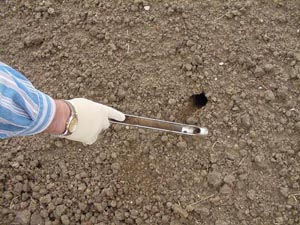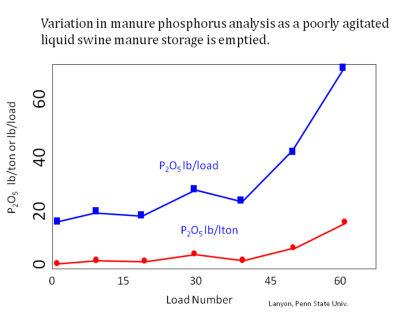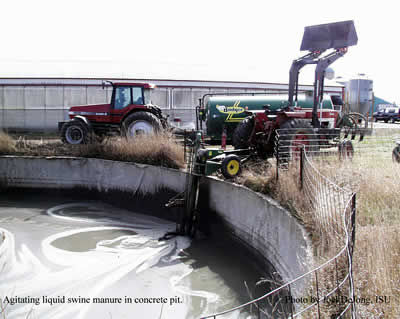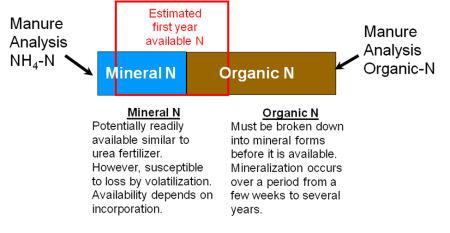Manure nutrient analysis will vary from sample to sample on a farm even with consistent management and careful sampling. Generally, a running average of manure analyses will better reflect what is in the manure than any one sample result. Also, most of the sampling methods outlined here recommend sampling at the time the manure is being spread. This means that manure analysis results will not be available until after the manure is already spread. Therefore, nutrient management plans should be based on previous test results.
Creating a Baseline For Your Manure Analysis Records
It is recommended to test manure annually for at least 3 years to establish a running average manure analysis that is used in the following year to develop the nutrient management plan. If there is significant variation within this time frame the 3-year period should be extended. Determine what might cause the variation. Can management changes be made to reduce the variation (eg. better sampling, better agitation, etc.)? Can management changes be made to react to the differences from year to year (eg. increasing rates in a year when above average rainfall dilutes the manure, or adjusting rates based on changes in animal feeding, etc.)
Once a baseline is established, less frequent manure testing may be acceptable. When a new manure test is run, it should be compared to the running average. If the new analysis is consistent with the average it can be added to the running average. If there is a trend, for example manure analyses are slowly and consistently increasing or decreasing over time, the oldest value in the running average should probably be dropped when the new value is added.
What If You Receive an Abnormal Manure Test Result?
If the new manure test result is very different from the running average, immediately try to determine the cause. Evaluate the sampling procedures, especially if there were no obvious management changes. Consider having the sample rerun or submitting a new sample if possible to confirm or correct the analysis. Look for management changes such as major changes in animal feeding; changes in dilution water in liquid manure (more or less rainfall, changes in washwater added, etc.); or changes in manure handling (manure scraped from barn floors more or less frequently, different bedding management, etc.).
If the change was a one-time occurrence do not add this value to the running average. If a permanent management change was made a new round of more intensive sampling should be initiated to establish a new baseline for future planning.
Also, management adjustments may have to be made after manure application, such as applying more or less supplemental fertilizer to fields where the manure was spread. Plan to apply supplemental fertilizer after manure application is complete and actual manure nutrient application is known based upon a current manure sample.
The data below from a PA dairy farm illustrates how records are used to develop a useful manure analysis program. Only the N and solids analysis are shown here but all test results would be analyzed similarly.
|
Manure Test N |
Running Average N1 |
Solids |
| Year |
lb/1000gal |
lb/1000gal |
% |
| 1 |
28 |
28 |
6.8 |
| 2 |
25 |
27 |
7.8 |
| 3 |
26 |
26 |
7.4 |
| 4 |
352 |
26 |
10.4 |
| 5 |
26 |
26 |
6.2 |
| 6 |
26 |
26 |
6.1 |
| 7 |
29 |
27 |
7.5 |
| 8 |
363 |
36 |
8.8 |
| 9 |
34 |
35 |
8.1 |
| 10 |
35 |
35 |
8.3 |
1Used to develop the nutrient management plan
2Value does not fit the trend. A review of the situation indicated that this was an abnormally dry year, thus there was less dilution from rainfall. Notice that the % solids were higher than they had been, which is more evidence that the dry year was the culprit. This value was not included in the running average. The farmer reduced his sidedress nitrogen (N) rate slightly that year to account for the higher N analysis and also lower yield potential because of the drought.
3The N analysis changed dramatically in this test. However, the farmer had a made a major change in his feeding program, replacing corn with distillers grains. This would be consistent with the increased N in the manure. Since this was likely a permanent change, a new running average was started. Since the change in feeding management was known, some educated guesses about how this would affect the manure analysis were used to make adjustments in the nutrient management plan for year 8 rather than using the existing running average.
Related Web Pages
Page Authors: Douglas Beegle, Pennsylvania State University and John Peters, University of Wisconsin Reviewers: Jerry Martin, Pennsylvania State University and Rick Koelsch, University of Nebraska
 Farmers and ranchers are becoming increasingly aware of the importance of soil quality/health to the productivity and sustainability of their agricultural system. Research and field observations have demonstrated that carefully managed manure applications can contribute to improved soil quality with limited environmental and social risks. However, a comprehensive assemblage of outputs and conclusions from research studies, field trials, soil labs databases, and other sources has never been developed. Therefore, the purpose of the initiative, Manure & Soil Health: Understanding and Advancing the State of the Science, is to assemble current knowledge on this topic, make it available to those influencing manure and land management decisions, and use it to inform and facilitate future research and service needs. The intent of the roundtables is to improve our understanding of: current knowledge, critical and emerging issues for which there are knowledge gaps, and information needs of farmers and their advisors.
Farmers and ranchers are becoming increasingly aware of the importance of soil quality/health to the productivity and sustainability of their agricultural system. Research and field observations have demonstrated that carefully managed manure applications can contribute to improved soil quality with limited environmental and social risks. However, a comprehensive assemblage of outputs and conclusions from research studies, field trials, soil labs databases, and other sources has never been developed. Therefore, the purpose of the initiative, Manure & Soil Health: Understanding and Advancing the State of the Science, is to assemble current knowledge on this topic, make it available to those influencing manure and land management decisions, and use it to inform and facilitate future research and service needs. The intent of the roundtables is to improve our understanding of: current knowledge, critical and emerging issues for which there are knowledge gaps, and information needs of farmers and their advisors.








